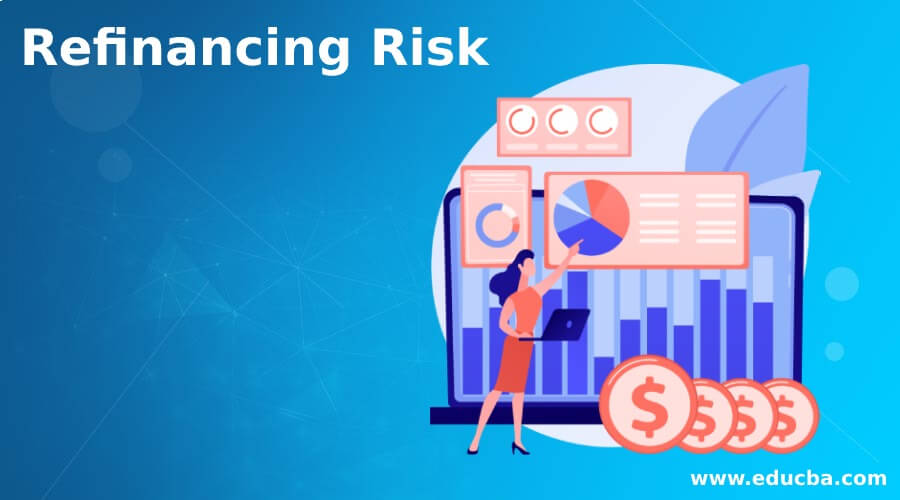Updated July 7, 2023

Definition of Refinancing Risk
Refinancing risk is the risk that is associated with the debt obligation. The borrower will not be allowed to replace its debt obligation with new debts during the crucial hours to needs. The level of refinancing risk is associated with the credit rating of the companies.
If a company has a good credit rating, the refinancing risk associated with that company is shallow. The company carries the risk of refinancing if the business failure happens at any stage.
Explanation
The refinancing risks occur when a borrower cannot refinance the company’s existing debt. For example, many times, it has been seen that when a borrower takes a balloon payment option, then, in that case, they take some amount as a loan to pay the final amount of the balloon payment. In this scenario, they make another liability to clear the existing liability, and sometimes it becomes difficult for them to do so. So then it becomes the refinancing risk.
Example of Refinancing Risk
A company is in a manufacturing business and has an excellent turnover. Still, due to a sudden recession in the market, the raw material prices increased, and the company is now in debt. The short-term debt for the year amounted to $2500, and the outstanding debt came to $950. So the company has to realize its assets to meet its obligations. Because of the recession, the company could not take any loans further to pay off its existing debts, and thus, the refinancing risk occurred. The total assets of the company were approximately $3500. Therefore, the financial crunch in the market has led to refinancing risk for the company.
| Particular | Amount($) |
| Short-Term Debt (A) | 2500 |
| Debt outstanding (B) | 950 |
| Total Liability (C) = (A) + (B) | 3450 |
| Total assets realized (D) | 3500 |
| Remaining amount (E) = (D) – (C) | 50 |
Even though, in this case, the company’s assets are more than its liability, it will be declared insolvent. As a result, the company will not be able to raise any liquid funds to pay off its creditors.
Refinancing Risk for Ranks
The refinancing risk for banks is an opportunity to make huge profits from the customers. The customer asks the banks to raise their credit limit per their requirement, and the bank charges enormous interest. The banks check the customers’ repayment capacity and the mortgaged interest rate. The bankers also analyze the past credit score of the customers before incremental their credit limits. Therefore banks also act as essential players in the market during the financial crisis.
How to Avoid Refinancing Risk?
- It is avoidable by maintaining the credit score throughout the year.
- The customers can work on the limits of the previously taken loans to make their credit scores manageable when refinancing.
- It can be avoidable by properly planning the loans and the credit score so the risk can be null.
- It is always advisable that the customers should avoid the refinancing risk.
- The borrower should not refinance if the refinancing scheme is unrealistic.
- The borrower should be aware of the possibility of the risk, and he should take all possible measures to mitigate the risk.
- The company should check for its assets. If this refinancing risk occurs long-term, what realizable assets can they use to mitigate it?
- Every risk can be mitigated and avoided; proper planning and timely execution are necessary.
Refinancing Risk Management
- It should be mitigated from a very early stage.
- The lender should take all possible precautions to check the credit score.
- It can worsen when the market is unfavorable and the interest rates are very high.
- The borrowers’ liquidity is at stake; therefore, it should be under appropriate management.
Advantages
Some of the advantages are as below:
- The banks can gain in this refinancing scenario when the interest rates are higher than in the present system.
- It also helps the investors to raise short-term loans to pay off their long-term loans; therefore, the long-term liability gets paid off.
- The interest rate is also lower for short-term loans than for long-term loans.
- It can save money on interest costs.
- After proper planning, the risk of refinancing can be removable.
- It can be avoidable to a greater extent.
Disadvantages
Following are the disadvantages are as below:
- It can significantly affect the lender’s and borrowers’ business.
- It can result in bankruptcy as well.
- The borrowers are insolvent even if their company’s assets are more significant than the liabilities.
- It can be short-term and long-term, and if it is for the long term, then the rate of risk is higher.
- It can be for an individual and any bank and financial institution.
- Worsens when a liquidity crunch in the economy occurs because the company is considered insolvent despite having more assets than liabilities. After all, it will not be able to raise liquid funds for the creditors.
Conclusion
The refinancing risk is also known as rollover risk. It can occur to any individual and bank. The company should take all possible measures to mitigate the risk of refinancing. The borrowers who are unable to finance the existing loan opt for this type of scheme. It lowers the interest rate to a greater extent; thus, the borrowers plan to refinance their long-term loans by taking short-term loans. But the only key to getting maximum returns from this refinancing risk is understanding the whole process and then involving in this refinancing.
Recommended Articles
This is a guide to Refinancing Risk. Here we also discuss the definition and how to avoid it with advantages and disadvantages. You may also have a look at the following articles to learn more –

